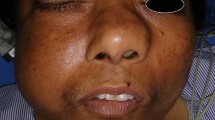Abstract
Schwannomas are uncommon benign encapsulated slow growing neural neoplasms which originate from Schwann cells of peripheral, cranial and autonomic nerves. Schwannomas are usually solitary lesions but can be manifold when associated with syndromes. Surgical excision is the treatment of choice of schwannomas, with few and controversial reports of recurrence or malignant transformation. This article reports a rare case of a solitary benign schwannoma arising from the infraorbital nerve which presented as an asymptomatic swelling in the right cheek region of the face. Treatment was carried out with the patient under general anesthesia by complete excision with preservation of the nerve and without significant postoperative morbidity.




Similar content being viewed by others
References
Woodruff JM, Marshall ML, Godwin TA, Funkhouser JW, Thompson NJ, Erlandson RA: Plexiform (multinodular) schwannoma. A tumor simulating the plexiform neurofibroma. Am J Surg Pathol 1983;7:691–97.
Verocay J. Multiple Geschwulste als Systemerkrankung am nervosen Apparate. Festschrift fur Chiari, Wein and Leipzig, 1908:378.
Stout AP. The peripheral manifestations of the specific nerve sheath tumor (neurilemmoma). Am J Cancer 1935;24:751–96.
Gennaro P, Nastro Siniscalchi E, Gabriele G, Cascone P. Trigeminal and facial schwannoma: a case load and review of the literature. Eur Rev Med Pharmacol Sci. 2012;16(4 Suppl):8–12.
Bertherat J. Carney complex (CNC). Orphanet J Rare Dis. 2006;1:21.
Fletcher CD, Davies SE. Benign plexiform (multinodular) schwannoma: a rare tumor unassociated with neurofibromatosis. Histopathology. 1986;10:971–80.
Rouleau GA, Merel P, Lutchman M, Sanson M, Zucman J, Marineau C et al. Alteration in a new gene encoding a putative membrane-organizing protein causes neuro-fibromatosis type 2. Nature. 1993;363:515–21.
Evans DG, Sainio M, Baser ME. Neurofibromatosis type 2. J Med Genet. 2000;37:897–904.
Kurtkaya-Yapıcıer O, Scheithauer B, Woodruff JM. The pathobiologic spectrum of schwannomas. Histol Histopathol. 2003;18:925–34.
Chen TW, Chen CJ, Leung KW. Recurrent schwannoma of upper neck—a case report. Taiwan J Oral Maxillofac Surg. 2009;20:60–7.
Ramina R, Neto MC, Fernandes YB, Leal AG. The surgical management of trigeminal schwannomas. Samii’s Essent Neurosurg. 2008:155–64.
Frazier CH: An operable tumor involving the gasserian ganglion. Am J Med Sci. 1918;156:483–90.
Hasegawa T, Kida Y, Yoshimoto M, Koike J: Trigeminal schwannomas: results of Gamma Knife surgery in 37 cases. J Neurosurg 2007;106:18–23.
Chen SH, Tsai PY, Tsai YH, Lin CY. Postoperative nerve injury and recurrence in surgical treatment of head and neck schwannomas. Asian J Arts Sci. 2011;2:116–25.
Compliance with ethical guidelines
Conflict of interest
The authors state that there are no conflicts of interest.
Informed consent was obtained from the patient described in the manuscript.
Author information
Authors and Affiliations
Corresponding author
Rights and permissions
About this article
Cite this article
K. S., M., Jain, M., Hurakadli, M. et al. Extracranial schwannoma of the infraorbital nerve. J. Stomat. Occ. Med. 7, 60–62 (2014). https://doi.org/10.1007/s12548-014-0106-2
Received:
Accepted:
Published:
Issue Date:
DOI: https://doi.org/10.1007/s12548-014-0106-2




